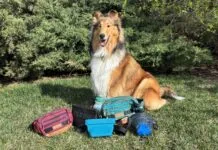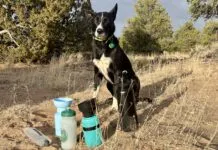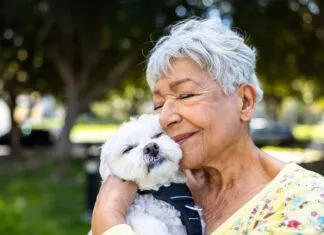As you see your beloved old dog’s muzzle beginning to gray, it’s natural to consider adding a puppy to the household. You’d love for the next generation to learn from the best, and honestly, you’re thinking it would soften the eventual loss to have another dog already in the family.
But balancing the needs of dogs at opposite ends of the age spectrum can be tricky. Sure, sometimes it’s immediate bliss, with the senior feeling revitalized and stepping up to mentor the puppy! But just as often, the elderly dog is miserable with all of the new bouncy energy in the house, and the humans end up feeling divided, and unable to give either dog what they need.
It’s hard to know beforehand where your individual household will fall on that spectrum, but it’s wise to be prepared—so you’re ready to jump in to make it a success after all. Here are some questions to consider as you ponder whether it’s the best time for you to add that puppy to the family. (For much more detail, check out our new book: Old Dog, New Dog: Supporting Your Aging Friend and Welcoming A New One.)
How Will You Protect Your Senior from Puppy Energy?
People reasonably assume that if their older dog has always played well with his buddies, he will love having a puppy to play with at home. But—unlike those solid adult dog friends—puppies have not yet developed their social skills. They constantly jump in faces, bite too hard, grab tender body parts, and pounce unexpectedly. They haven’t yet learned that other dogs don’t enjoy all of that.
Perhaps you’re thinking that your senior dog is just the one to teach the puppy canine manners and communication skills! Well, that can be true, to a point. But the best lessons are taught by a willing professor, not one acting under duress. Expecting your senior to babysit the rude toddler 24/7 is unfair. (After all, the dogs didn’t choose this living situation—the humans did.) If you want your senior to guide well, interacting with the puppy must be optional, or you’ll find your puppy gets the wrong lessons.

And here’s a key point that’s easy to miss: A typical senior has begun to decline physically. Mind you, even if you are a very caring owner, there may be diminishment that you are not aware of! They have anywhere from minor aches to obvious tender spots that they protect. They may have begun to lose some eyesight or some hearing. That means the incoming puppy missile is not just irritating but is, in fact, scary for them. That can result in unwelcoming behavior you never would have anticipated: “Oh my gosh, I’ve never seen her snarl like that!”
So, if you bring a puppy into the household, your first priority is to protect your senior’s peace—both physically and psychologically. If your older dog would normally relax into long naps, but is perpetually on guard because an enthusiastic, full-of-energy pup might barrel in at any moment, we’ve let her down. Just because she’s being “nice” about it—i.e., hasn’t growled, snapped, or bitten—doesn’t mean it’s OK! I often hear folks raving about how tolerant an old dog has been with a puppy, and I keep thinking, “Please don’t put that sweet old soul in a position where she constantly has to tolerate things.” She’s earned her peaceful, undisturbed days.
What can you do in the first weeks and months to set up both dogs for success?
- Always provide an escape option for your senior.
- Closely supervise the times the dogs have free access to each other, observing body language closely and cheerily redirecting when either of them is overwhelmed.
- Never punish your old dog for growling; that’s good communication. If the puppy does not immediately adjust the behavior that elicited the growl, it’s time for you to step in to give your oldie a break by engaging the pup elsewhere.
- When you can’t actively supervise, separate the dogs. Use pens, gates, crates, leashes, and a division of labor between the humans.
- Build the dogs’ relationship by leading fun, joint, controlled activities—like a simple three-minute treat-filled training session or a 10-minute sniffari on leash. Dogs feel safer when a situation is predictable, so these moments create a positive association and a feeling of trust.
Want your senior and your puppy to start off on the right paw? Don’t just wing it! Instead, the day before the puppy comes home, create a clear plan for the introduction.
Plenty of people will give you a detailed map of the one way that works. Hogwash. There are countless approaches that can succeed, as long as you commit fully to this principle:
- AGENCY: Both dogs need to feel that they have the ability to give themselves the distance and time they need to assess the situation.
When you’re holding a puppy tight in your arms, or restraining your adult with a leash, it interferes with their sense of agency. That’s why the best introductions often happen through a see-through barrier (pen, fence, gate) when both dogs have four paws on the floor. That way they each have the option of moving closer to sniff or farther away to observe.
The other general key to success: Be patient. If there’s good body language on both sides—obvious interest, no retreats, loose bodies, play bows—fantastic! Now, though I know you want the answer to be “remove the barrier,” continue to wait! Sometimes, to go fast you have to go slow. The more time you give these two to get to feel comfortable with each other while that barrier is still up, the faster you’ll get to the time when it’s safe to remove that barrier.
(For much more detail, check out our book Old Dog, New Dog: Supporting Your Aging Friend and Welcoming a New One.)
How Will You Enrich (And Tire Out!) Your Pup?
The happiest senior/puppy matches are the ones where the puppy has plenty of outlets—other than the senior—for all that puppy energy and curiosity. There are so many options, and the best approach is to combine them all:
- Playdates with well-matched puppies or puppy-friendly dogs are absolute game-changers.
- Brain games. A three-minute training session—sit, touch, spin, through, down, come—does wonders for a bored pup looking for engagement. Throw half a dozen of those into your day and your pup will be less desperate to obsess over your senior in the constant search for fun.
- Outdoor time. Half an hour spent outside fulfilling natural canine needs (such as sniffing and digging) does wonders.
- Give your puppy a way to forage “naturally” for food; ditch the bowl and offer meals in the form of food scatters, stuffed Toppls, puzzle toys, and homemade challenges, like kibble hidden in crumpled paper stuffed inside the cardboard box that came today.
- Goofy human play. Structured games like fetch can be great, but don’t forget to relax and have fun bonding with your puppy by offering play bows, rolling around, etc.
When all of that happens regularly, puppies come back to their senior nicely spent. They say hi to their sweet old dog sibling with a nice sniff, and flop down to relax. Now that’s a puppy an old dog can start to like! You might even finally see the senior actually approach the puppy: “Hey, um, I haven’t seen you much today…”
Can You Make Time for Puppy Socialization?
Brand new puppies who have a senior to toddle after usually take to the idea of a leash walk weeks before singletons do. That’s great!
However, the key role of the first few months of walks is to socialize the pup. This is how we carefully introduce him to the world, helping him feel comfortable with all of the new things he’ll encounter. To do that well, it’s critical to note the puppy’s reaction in the moment and dial the intensity of each experience up or down to meet him where he is. For example, let’s say you want to get your pup to feel comfortable around kids, so you’ve approached a fenced playground where kids are having loud, fast fun. If the puppy is interested and moving toward the sounds, wonderful! If he’s hanging back or turning away, though, you’ll want to stop at a comfortable distance and allow him to observe.
What does that mean for your senior? If your senior is an absolute angel out in the world, and can constantly model a calm, confident reaction to loud trucks, fast scooters, barking dogs, unpredictable kids, and will have the patience to stop, wait, and turn around a dozen times each walk, then your senior is a wonderful addition to your socialization adventures! But for most of us it’s too hard to socialize a puppy well with any other dog also in tow.
So, think about how you might make sure to find time to socialize your puppy well—without depriving your senior. Maybe every day as you head out with your puppy, the pattern is that the senior always gets a frozen stuffed food toy, or special cuddle time with another member of the household.
What about When Your Senior Declines?
It’s natural to wish for new beginnings and some fresh joy when you begin to feel sad that losing your senior is around the corner. A puppy can be just the thing, truly! While the demands of puppyhood are high, there is so much sweetness, laughter, and new life folded into that package.
However, let’s picture that you’re just able to make it work and you’re keeping all of the balls in the air. But then . . . your senior’s health begins to decline. How will you feel as you’re navigating meds and diagnoses and how to best support your old friend—when at the same time you’re trying to find the time and energy to potty-train and socialize a puppy? Maybe it’ll feel like too much. Or maybe switching gears between those two dear dogs at that time is just what the doctor ordered for you. It’s different for everyone. We just want you to take a beat and think it through before diving in.
Of course, we hope your senior has years and years of good time left! You may get all the way through puppyhood with a very healthy senior, and then when she nears the end you’ve got a lovely young adult dog at your side who has been fully shaped by your dear old friend. That’s the dream.








